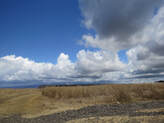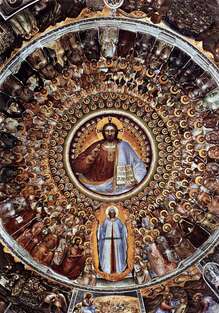 the saints offer hope the saints offer hope During this time of year the liturgical calendar contains some of my favorite saints (and angels) celebrated at Mass and in our prayer. Of course, the Church honors a diverse array of saints throughout the year, not only because of their holiness, but because they serve as inspiration to the faithful. The saints offer hope because their lives reveal that holiness arises in many ways, and they prove that everyone has the potential to become holy no matter who they are or how they express it. Generally, the saints we find most fascinating are usually the ones that draw us to Christ: therefore, the liturgical calendar invites us to know the saints who were martyrs, ascetics, itinerant preachers, cloistered religious, those who taught the rich, served the poor, and every variety of folk who lived the gospel as an expression of their love for God. There were even those referred to as holy fools, men and women who defied convention and societal norms, drawing attention to God by living the gospel radically. Each had a unique calling, responding uniquely in kind. Thus, we can approach each and every saint to prayerfully intercede or to act as inspiration in discerning our own pathway to attain holiness. 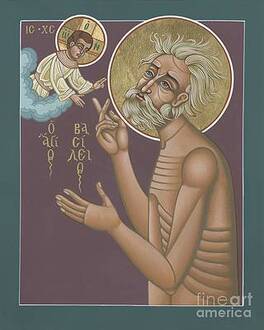 they challenge our comfortibility they challenge our comfortibility The holy fool is perhaps the most challenging to understand since they embrace lifestyles that may seem absolutely crazy. Holy fools literally choose to become the subject of derision, though to those who grasp their lived message they are as wisdom figures, despite incomprehensible behaviors that most people would never choose personally. These people might adopt ‘strange’ habits while usually living very simply. Often they give whatever they receive as alms to those they deem poorer than themselves. Sometimes the life of a holy fool seems a bit ‘off-putting’ due to its strangeness, and there are many who would consider them insane, but if we see with eyes attuned to the gospel, their selfless generosity, mercy, and love will become apparent. The choice of lifestyle of the holy fool can wordlessly challenge our own comfortability, obliviousness toward the poor in our midst, or even our vanity, which could be why we find them so distasteful and incomprehensible. Holy fools, however, are willing to be misunderstood, in response to Jesus who was also considered a fool and a threat during His life. 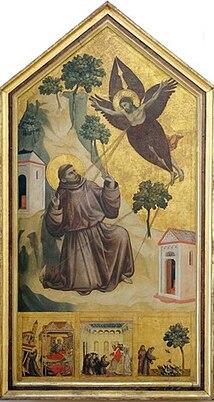 St. Francis, the Poverello St. Francis, the Poverello Challenging as they are, it is interesting that one of the most popular male saints in church history was a holy fool and few seem to hesitate embracing him: St. Francis of Assisi (feast day, October 4). Francis traveled throughout the Italian countryside, and on occasion beyond, working with lepers and the poor, while embracing Lady Poverty, a term he used for living with complete freedom from ownership. Francis was far more than the saint who loved nature; he was a renowned preacher who sometimes stood up to authority, always with love, determination, and humility. However, some of his behaviors led to rumors, even among the Franciscans, that he had lost his mind. Francis was aware that not everyone was called to live as he did, nor did he expect it of them, which is why near the end of his life he left the community he had founded, choosing instead to live in a cave. There he received the stigmata, dying blind and frail only a few years later (at the age of 45) having lived a life of joy even in his suffering, borne of his love for Christ. 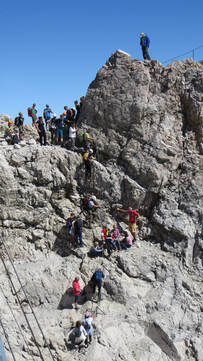 it is a choice to live counter-culturally it is a choice to live counter-culturally If we consider the saints carefully we will see that living a life of holiness is a choice to live counter-culturally; any time we choose to live our faith, which is (unfortunately) outside of ‘cultural norms,’ we are choosing against the values of the world and for that which is deemed foolish. Thus, we have saints who chose varying states of ‘foolishness’ such as Thérèse of Lisieux who embraced a life of obscurity, and yet even in dying young had a tremendous impact; St. Peter Claver chose to spend his life working with slaves on the ships in which they were imprisoned, ultimately dying from disease he contracted as he worked to ease their suffering; St. Andrew Kim and his companions chose martyrdom rather than to renounce Christ; St. Jerome spent his life translating the Bible and penning volumes of letters and treatises; St. Wenceslas, a king, chose to give his wealth in aid to the poor (indeed that was seen as foolish!); St. Padre Pio chose to accept the stigmata so that his suffering would alleviate that of others; and St. Faustina was ridiculed by members of her own community during her short life, working in the convent arduously while simultaneously receiving Jesus in visions, and still managing to write it all down in a rather large volume, (her Diary). 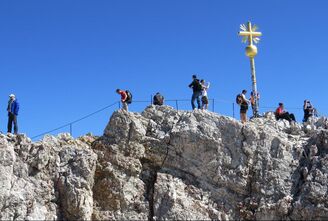 living the gospel will render us fools in the eyes of the world living the gospel will render us fools in the eyes of the world To choose to grow in holiness, a reality to which we are all called, * is what embracing our faith is about. We should never fear being considered a bit of a fool for following Jesus. As St. Paul said, “The foolishness of God is wiser than human wisdom….” (1 Corinthians 1:25) Living the gospel will render us as fools in the eyes of the world, but if we are serious about our faith, then we should work at making God’s foolishness our own, while also inviting others into our foolishness. The saints are those who made that choice, serving humbly through works of mercy and love. They invite us to grow as they did; through their example they can guide us to live our distinct call, which in turn can inspire our brothers and sisters to go and do likewise. 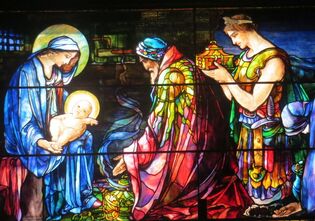 May we look to the saints for inspiration, guidance, and intercession in living the call we have received! May we embrace the foolishness of God in order to gain wisdom! And may we grow in holiness as we seek to love Christ more by loving those to whom we are sent! Let us meet in the Heart of Jesus! Peace! © Michele L.Catanese * One of the documents of Vatican II is called Lumen Gentium. The fifth section of Lumen Gentium is called The Universal Call to Holiness, and as the title suggests, it goes into depth as to how the call to holiness is not exceptional, but is something everyone should work toward because it is available for all the faithful. https://www.vatican.va/archive/hist_councils/ii_vatican_council/documents/vat-ii_const_19641121_lumen-gentium_en.html Images: 1. Dome fresco, Paradise, ca. 1378, by Giusto de’ Menabuoi (Italian, ca. 1320–1391), Padua Baptistery, Italy. 2. Icon, St. Vasily The Holy Fool, by Fr. William Hart McNichols. If you want to purchase a copy, you can find this at https://fineartamerica.com/featured/st-vasily-the-holy-fool-246-william-hart-mcnichols.html 3. Painting, St. Francis Receiving the Stigmata, by Giotto. This is found in the Louvre in Paris. 4. My photo, climbers on Jugspitz in the Alps, Germany. This seems to be foolishness, but is it? 5. My photo, climbers on Jugspitz at their destination. Perhaps it is God's foolishness. 6. My photo, Tiffany stained glass in chapel on St. Simons Island, Georgia. Is the Nativity not God's greatest 'foolishness' of all?! Glory to God in the Highest! Note: In compliance with GDPR rules, I wish to make it clear that I do not gather any information on any of my readers at any time. 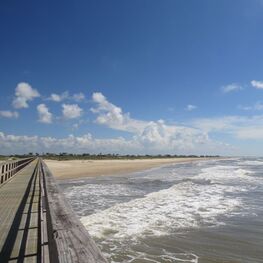 My peace I give to you My peace I give to you “Peace I leave with you; my peace I give to you. Not as the world gives do I give it to you.” Jesus spoke these words at the Last Supper as part of a long discourse given just before He went to Gethsemane to begin His agony. (John 14:27) These were not just words meant to be uplifting: before He went into the Garden He left the great gift which above all else connects us to Him, and hence, to the peace only He can give. That is, He left us the Eucharist. In His prayerful discourse that night Jesus made it clear that we do not have to wait until Heaven for peace, but that He intends it for this life. It makes me wonder, then, why we are so slow to grasp or accept the gift we have been given for the here and now. How often we spend our lives searching for peace and yet we already have it in and through Jesus Christ! As He said, this peace cannot be found in anything worldly, but it is the peace only God can give, and as such, it is found in Him. Rather than to simply instruct us to seek it, Jesus provided an everlasting gift at the very moment when He blessed and broke the bread. 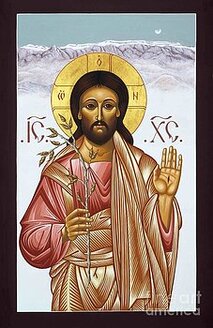 Everything we need for our spiritual wellbeing.... is found in Christ Everything we need for our spiritual wellbeing.... is found in Christ The peace of Christ is found in the Eucharist; everything we need for our spiritual wellbeing, as well as the graces we need to live the Christian life in a turbulent world, is found there. However, these graces need to be cultivated through prayer if we want to grow in holiness and in the peace He alone can give. Without a personal relationship with Jesus, peace would be fleeting because it would lack grounding in the trust that grows through time spent with the God of Love and Mercy. It is through prayer that we learn to recognize the presence of Jesus, graces offered, and are enabled in discerning the path to which we are called. Prayer ‘grows’ our trust in Him which in turn enlivens the peace Jesus gives. His peace is unshakeable: it remains deep within us no matter what we are going through. In other words, having peace does not mean we will not suffer, but that when we do, we trust that He is present in the midst of whatever it is we are dealing with. This peace is not something one feels, but it is His deep abiding presence within our heart that protects us from giving into fear and despair. 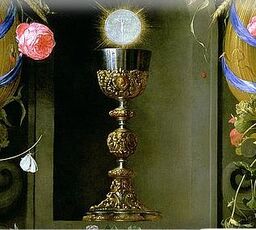 the Real Presence of God the Real Presence of God Jesus gave His Body, Blood, Soul, and Divinity as an eternal gift, the source of all grace and peace. Let me put it another way: the consecrated Eucharist IS Jesus. Unless we believe that in reality Jesus is present after the priest says the words of institution and consecrates the bread and wine; unless we have the reverent belief to accept that we are in the very real presence of God when this happens, we cannot fully appreciate or experience the power and grace He offers. He made it clear that this peace is not to be found anywhere but in Him: “…my peace I give to you. Not as the world gives do I give it to you.” And He concludes with this: “Do not let your hearts be troubled or afraid.” (John 14:27) Notice that we have to choose to accept it as an act of humility and trust. 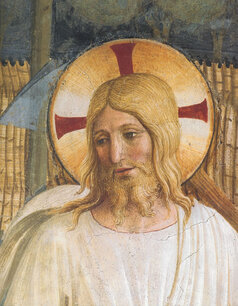 He wants us to be as Christ to others He wants us to be as Christ to others I once read about an atheist who said that if he believed what Catholics claim to believe about the Real Presence of Christ in the Eucharist then he would have to be torn away from the altar because he would never want to leave something as beautiful and wonderful as that.* Thus, Catholics should love the Eucharist as he inferred. It would be beneficial to reflect upon the Blessed Sacrament. While none of us, (even the monks), can live in front of the Tabernacle 24/7, we can grow in reverence and love, taking what we ‘feast upon’ within the church out into the world when we leave the building. That is the entire point: Jesus wants us to have peace so that we also have the courage and strength to live our faith unashamedly and boldly without any fear of what might happen if we do. He wants us to be as Christ to others, becoming His hands and feet, offering His mercy and His love. The Eucharist fuels this because as the saying goes, we are what we eat. 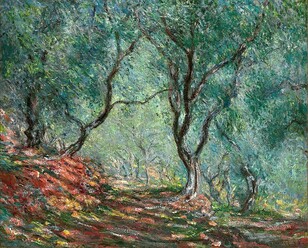 It is in joining ourselves to Christ that we find peace It is in joining ourselves to Christ that we find peace The world is full of many deceptive claims for peace outside of Jesus. We are inundated with ideologies, practices, and messages that say power, money, and prestige can bring happiness, and hence peace. Unfortunately all of these are fleeting. It is not health or sickness, wealth or poverty, long life or short that determines our peace. It is in joining ourselves to Christ, accepting His gifts given through prayer and the sacraments, that we find peace and ultimately joy. Remember, the peace and subsequent joy offered by Jesus are interior dispositions and not feelings. We can be in outward difficulty or suffering, and still have peace. It is this peace that enabled saints like Padre Pio, who lived with constant physical and interior pain from betrayals and attacks, to still live with interior peace. So let us take Jesus at His word, accepting the gift of peace by immersing ourselves in the Eucharist. In it, everything we need is found because Christ Himself is present. There is no greater gift: All we need is found in Him! May we cling to Jesus especially through the gift of His Body and Blood! May we immerse ourselves in prayer more readily so as to discern the path God has for our growth in holiness and our service in mercy to one another! And may we trust in Him to find the peace that only He can give! Let us meet in the Eucharist! Peace! ©Michele L. Catanese * If anyone has any idea who said this, or to whom it was said, I would love to know. I cannot remember where I read this, though I am confident it was said to someone famous who then recorded it, perhaps a saint. Images: 1. My photo, Matagorda Bay facing the shoreline. Matagorda, Texas. 2. Icon, Nuestro Salvador de las Sandias, by Fr. William Hart McNichols. This icon can be found in one of many mediums at fineartamerica.com/featured/nuestro-salvador-de-las-sandias-012-william-hart-mcnichols.html 3. Painting, inset of Chalice and Host by Jan Davidsz de Heem 4. Fresco painting, Resurrected Jesus, (close up) by Blessed Fra Angelico. 5. Painting, Olive Trees in Bordigher (1884), by Claude Monet. Note: In compliance with GDPR rules, I wish to make it clear that I do not gather any information on any of my readers at any time. |
Heart Speaks to Heart
|
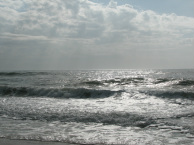
 RSS Feed
RSS Feed
